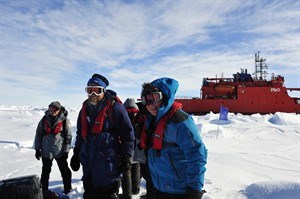
In this photo provided China's official Xinhnua News Agency, the first group of passengers aboard the trapped Russian ship MV Akademik Shokalski arrive at a safe surface off the Antarctic Thursday, Jan. 2, 2014. A helicopter rescued all 52 passengers from the research ship that has been trapped in Antarctic ice, 1,500 nautical miles south of Hobart, Australia, since Christmas Eve after weather conditions finally cleared enough for the operation Thursday. (AP Photo/Xinhua, Zhang Jiansong) NO SALES
January 05, 2014 - 6:55 AM
CANBERRA, Australia - A U.S. Coast Guard heavy icebreaker left Australia for Antarctica on Sunday to rescue more than 120 crew members aboard two icebreakers trapped in pack ice near the frozen continent's eastern edge, officials said.
The 122-meter (399-foot) cutter, the Polar Star, is responding to a Jan. 3 request from Australia, Russia and China to assist the Russian and Chinese ships because "there is sufficient concern that the vessels may not be able to free themselves from the ice," the Coast Guard said in a statement.
The Russian research ship Akademik Shokalskiy has been trapped in ice-clogged Commonwealth Bay since Christmas Eve, while the Chinese ship which came to its rescue, Xue Long or Snow Dragon in Chinese, reported on Friday it too had become stuck nearby.
A day earlier, the Chinese ship's helicopter had retrieved from the Russian ship 52 scientists, journalists and tourists who are now on their way home aboard an Australian icebreaker, Aurora Australis.
Authorities say the 101 crew aboard the Chinese ship and 22 aboard the Russian ship were well provisioned and in no immediate danger.
The Polar Star cut short its planned stop in Sydney, Australia, to assist. It left Sydney on Sunday morning local time, Coast Guard spokeswoman Chief Warrant Officer Allyson Conroy said in an email.
"Our highest priority is safety of life at sea, which is why we are assisting in breaking a navigational path for both of these vessels." Vice Adm. Paul F. Zukunft, the Coast Guard Pacific Area commander, said in a statement. "We are always ready and duty bound to render assistance in one of the most remote and harsh environments on the face of the globe."
The Australian Maritime Safety Authority's Rescue Coordination Centre, which oversaw the rescue, said the Polar Star, the Coast Guard's only active heavy polar icebreaker, would take about seven days to reach Commonwealth Bay, depending on weather.
After the Snow Dragon reported it was stuck on Friday, AMSA told the Aurora to stay in the area, with its rescued passengers on board, in case help was needed. Under international conventions observed by most countries, ships' crews are obliged to take part in such rescues and the owners carry the costs.
On Saturday, AMSA said the Aurora was allowed to continue and that the Chinese and Russian ships were safe.
Andrew Peacock, an Australian doctor and photographer who was rescued from the Russian ship, said he and his fellow passengers "have been and continue to be thankful for all the help we have been given and ... aware of the cost and inconvenience to others."
"Handwritten notes of gratitude from each person rescued have been scanned and faxed to the captain of the Chinese ship and Chinese authorities and we remain concerned for that ship and the Akademik Shokalskiy which remain in the ice and we fervently hope that the Polar Star gets there quickly to free those vessels and their crew," Peacock said in an email from the Aurora on Sunday.
The Polar Star left its homeport of Seattle in early December to take part in one of its main missions, Operation Deep Freeze, to break a channel through the sea ice of McMurdo Sound to resupply and refuel the U.S. Antarctic Program's McMurdo Station on Ross Island.
A reporter for China's official Xinhua News Agency who is aboard the Snow Dragon, Zhang Jiansong, said an iceberg appeared over Thursday night and blocked the ship's return route. He said the ship would again try to find a way out, possibly as early as Monday when westerly winds would hopefully loosen the ice's grip.
Zhang said late Saturday that the 101 crew members on board the vessel were safe and had plenty of supplies.
The Snow Dragon was 21 kilometres (13 miles) from open water, he said.
___
Associated Press writers Kristen Gelineau in Sydney and Didi Tang in Beijing contributed to this report.
News from © The Associated Press, 2014